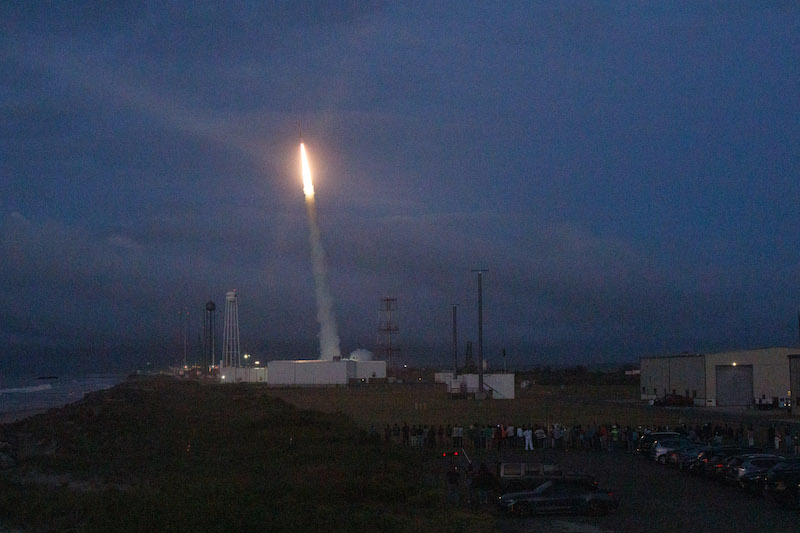


Reaching new heights
Photos courtesy of NASA and Ben Maruca August 15, 2025
UD student experiment soars into space aboard NASA rocket
It’s not every day a student experiment hitches a ride aboard a NASA rocket, but that’s exactly what a University of Delaware student team achieved earlier this week.
A sounding rocket carrying experiments developed by eight student teams from across the United States, including from UD, launched from NASA’s Wallops Flight Facility in Virginia on Tuesday, Aug. 12. It was part of NASA’s RockSat-X mission, which provides students with unique technical training and practical experience for future aerospace careers. The Delaware Space Grant Consortium sponsored the UD team’s participation.
The Terrier-Improved Malemute rocket reached an altitude of about 100 miles (162 kilometers) before descending by parachute into the Atlantic Ocean to be recovered.
Onboard the rocket from UD was a Langmuir probe, designed to collect information on super-charged space plasma, which can affect Earth in many ways, from producing auroras to disrupting communication and navigation systems, according to Bennett Maruca, associate professor of physics and astronomy, who was present with his team for the launch. They included Kiersten Ebersole and Marko Putnik, both juniors in mechanical engineering, and three alums who graduated with their bachelor’s degrees from UD this past spring — Khaled-Alameer Abdelnasser in computer science and engineering, and Nate Riehl and Kirin-Justin Stevens, both in electrical engineering.

Q: What is space plasma, and why is it important to study?
Maruca: Most of the universe is made of plasma — gas so energized that its atoms get stripped of electrons. Earth’s ionosphere is one of the few space plasmas we can reach, and it’s the frontline between our planet and space. Many of our spacecraft like the International Space Station fly through it, and it’s home to space weather.
Q: UD had a Langmuir probe aboard the rocket — what does it do?
Maruca: Essentially, a Langmuir probe is a metal electrode — the one on the University of Delaware Plasma Probe X (UDIP-X) happened to be a rod — that measures the electrical properties of plasma. Effectively, the plasma becomes part of the electrical circuit, and the probe measures how much current passes through it. From these measurements, we can infer the density and the temperature of the electrons in the surrounding plasma.
Q: What happens with the data now?
Maruca: All of the data were recorded on an industrial-grade microSD card (like the small memory card used in cameras), and now that we are back on campus, we soon will begin sorting them. The UDIP-4 team last year flew their experiment aboard the RockSat-C rocket, which reaches an altitude of 70 miles versus 100 miles for RockSat-X. They submitted a paper on their results just last month.

Q: What roles do the different members of the UD team have?
Maruca: Kiersten served as the team lead. Marko led the mechanical development of the experiment with some assistance from Kiersten. Nate and Kirin developed the electrical systems. Kirin worked on the power and digital systems. Nate led the analog system (which runs the Langmuir probe itself). Ameer developed the software running inside the experiment and the software for analyzing the data on the ground.
Q: What excites you most about this experiment?
Maruca: This is now the fifth RockSat team I've mentored at UD, and it's always so exciting and such a privilege to see the growth in these students — they come in knowing little or nothing about how to design systems for space flight, and in just a few months, they're leading a space mission. This year, though, has been extra special since this flight carried our Langmuir probe significantly higher than ever before.
Kiersten: I have dreamed of putting something in space since I was 13 years old and decided I want to be an engineer. I am eternally grateful to receive this opportunity to be a part of UD's first RockSat-X mission. I think what excites me most is the moment I can look up into the sky and reflect on the hard work my team has poured into this project over the past year.
Kirin: Getting to see something I worked so hard on come to fruition in such a tangible way. Like it’s right there in front of me, I get to see it blast off to the stars. I’ll never forget this or my team.
Ameer: Getting to develop something that goes beyond simulation and into the real world is always pretty surreal. This experience has the pinnacle of that feeling for me, I’m still so unbelievably grateful to have worked with my team and have been given this opportunity.
Marko: Having the opportunity to be involved in the design of an experiment from inception to launch was incredible. Watching something we worked so hard on go into space is a feeling beyond words.
Nate: The process of designing, building, and testing an experiment bound for space is unlike any project I’ve ever worked on. The sense of excitement, accomplishment, and fulfillment that comes with watching our work disappear into the sky is a feeling that can’t be replicated. Besides working with Kiersten, Kirin, Ameer, Marko, and Ben, collaborating with the technicians and engineers at NASA Wallops was an invaluable experience that strengthened my skills and inspired a career I hope to pursue.
Contact Us
Have a UDaily story idea?
Contact us at ocm@udel.edu
Members of the press
Contact us at mediarelations@udel.edu or visit the Media Relations website

